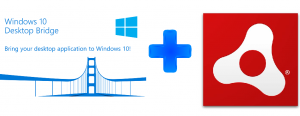Distribute your Adobe Air apps through the Microsoft Store with the captive runtime bundle
One of the great things about the Desktop Bridge is that it's provided new distribution channels - the Microsoft Store, Microsoft Store for Business, and the Microsoft Store for Education for software developers that up until the introduction of the Bridge, have had to rewrite their applications for UWP or not participate in Store. On the App Consult team, we have assisted Desktop Bridge developers using the plethora of Win32 runtimes: WPF, MFC, Windows Forms, VB.Net, Adobe Air as well as more esoteric runtimes like Electron, Java, and Flash with the MDM Zinc runtime (Google it with Bing!).
Adobe Air is a popular cross-platform runtime. Like most runtime environments, the Air runtime is updated separately from the application. No doubt, you've experienced the update prompt when starting an Adobe Air application. This introduces a complication when creating a Windows Store app using the Desktop App Converter. That is, while the app update is handled by the Store, the runtime is not. One solution is to do a chained DAC conversion of the runtime and the application. See this blog post for more information on chained installer conversions.
While a chained DAC conversion works well for some dependency scenarios, a better solution for Adobe Air apps is to package them as a captive runtime bundle. This packaging eliminates the issues with Air runtime updates since the runtime is packaged along with the app. See here for a full list of the benefits and drawbacks of this approach. After you've created the captive runtime bundle, you can do a Desktop App Converter manual conversion to package the application into an APPX file. See here for information on doing a manual DAC conversion.
Using Adobe's captive runtime bundle to package your Adobe Air apps will make your DAC conversions much easier!
More useful Desktop Bridge info here: Best Practices for Packaging and Common Issues for Desktop Bridge Apps!
